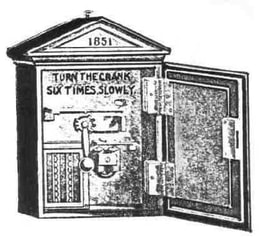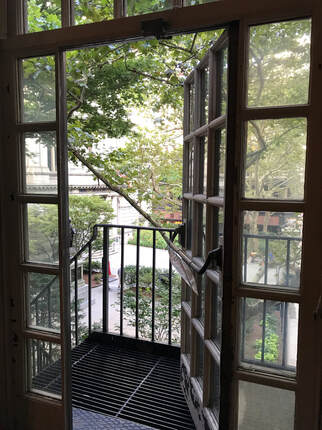|
By Christina Rewinski, Historic Site Educator  The red on this map denotes the area which burned in 1872, showing the devastating effect of the Great Fire on Boston. Image: Boston Fire Historical Society The red on this map denotes the area which burned in 1872, showing the devastating effect of the Great Fire on Boston. Image: Boston Fire Historical Society Fire is high on the list of threats to historic sites. All too frequently, horror stories of centuries-old buildings succumbing to flames make the news, and the public reacts with sadness at lost architectural treasures, as was the case when Notre Dame Cathedral in Paris caught fire in 2019. In November of 1872, Boston experienced tragedy as the largest fire in city history destroyed over 700 buildings. The fire was finally contained at the intersection of Washington and Milk Streets, mere blocks away from King’s Chapel. While this church remained unscathed, many neighboring historic sites burned, including Trinity Church, one of King’s Chapel’s daughter congregations. (The congregation of Trinity Church later moved from their Downtown Crossing location to a new building in Copley Square.) So it is extremely important for places like King’s Chapel to take every precaution available to protect their physical structures as well as all the people who visit.  Forty Forty telegraphic signal boxes—including one at Faneuil Hall—were installed throughout the city and put into use by 1852. Image: Firefighters Hall & Museum Forty Forty telegraphic signal boxes—including one at Faneuil Hall—were installed throughout the city and put into use by 1852. Image: Firefighters Hall & Museum Throughout its history, King’s Chapel has implemented systems and procedures to help protect against fires, updating them with technological advances. For instance, in 1852, the church installed its first official fire alarm system; it was connected to the city-wide electric telegraph system, the first of its kind in the United States. Boston’s telegraphic fire alarm system split the city into seven districts, each of which had multiple signal boxes. By turning a crank inside these signal boxes, witnesses could alert the superintendent of a nearby fire. This superintendent would then press a key for the corresponding district to set off a series of tolls from all the bells connected to the city-wide alarm system.  When alerted of a fire, the city superintendent would press a button to send out an electrical signal to each alarm bell. This signal would move an electromagnet, releasing a system of chains, weights, and a hammer that caused the bells to ring. Image: Firefighters Hall & Museum When alerted of a fire, the city superintendent would press a button to send out an electrical signal to each alarm bell. This signal would move an electromagnet, releasing a system of chains, weights, and a hammer that caused the bells to ring. Image: Firefighters Hall & Museum Thirty tolls notified firefighters of a fire and the subsequent number of tolls informed them of its location; for example two tolls would sound for a fire in district two. There was even a special signal to let firefighters know when a small fire was contained before their arrival. King’s Chapel was one of nearly sixty locations throughout Boston that was connected to the alarm and signal circuits of this system, stressing the importance of collaboration when dealing with fire prevention within a community.  In 1923, fire escapes were added toward the east ends of the galleries at King’s Chapel, providing points of egress from the church’s second floor. In 1923, fire escapes were added toward the east ends of the galleries at King’s Chapel, providing points of egress from the church’s second floor. In the early 20th century, King’s Chapel expanded its internal fire safety precautions to include a basic automatic sprinkler system, fire escapes, and eliminated use of the building’s coal boiler after a chimney fire. The sprinkler system was upgraded in 1940 to a more comprehensive alternative which included protection over the attic. This area saw further improvements in 1975, when a fire damper was added above the medallion which had once been a part of a cooling system. The basement sprinkler pipes were also inspected and rehung around this time. During church-wide renovations in 1991, the fire alarm system was updated and in the 21st century, King’s Chapel has continued to prioritize fire safety; today, there are pull stations, fire extinguishers, smoke detectors, and heat detectors in various locations throughout the building, as well as evacuation routes planned in case of emergency. With these ongoing improvements, King’s Chapel demonstrates its commitment to preemptive preservation, choosing to safeguard the building to the greatest possible extent. Sources:
Clancy, Goody. Historic Structures Report for King’s Chapel in Boston. June 2006. “The Fire Alarm Telegraph System.” Firefighters Hall & Museum.http://firehallmuseum.org/about-us-2/about-us/the-fire-alarm-telegraph-system/ “Great Boston Fire of 1872.” Boston Fire Historical Society. https://bostonfirehistory.org/fires/great-boston-fire-of-1872/ 1852, March 25. “The Municipal Telegraph: Its Machinery, Operation, and Uses”. The Woodstock Mercury. https://www.newspapers.com/newspage/489043736/
0 Comments
Leave a Reply. |
King's Chapel History ProgramDive deeper into King's Chapel's 337 year history on the History Program blog. Archives
July 2023
Categories
All
|


 RSS Feed
RSS Feed